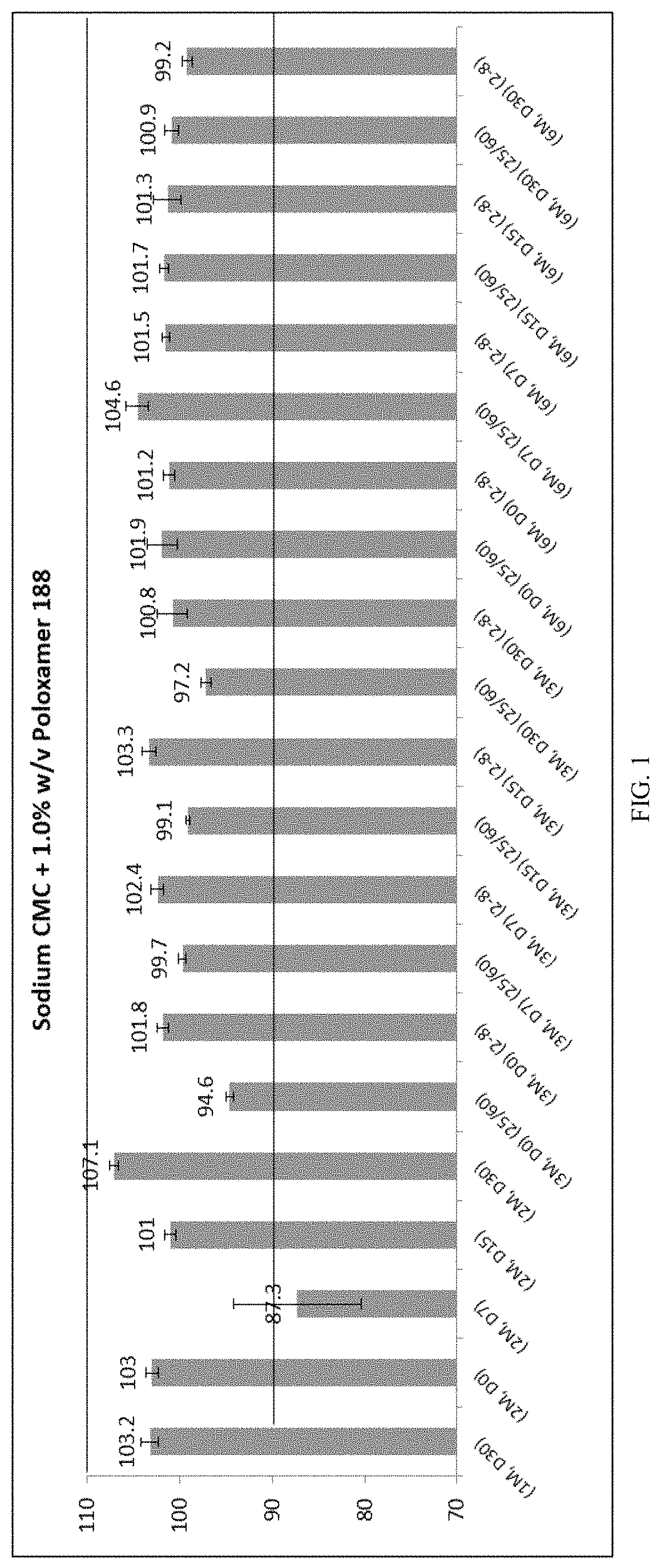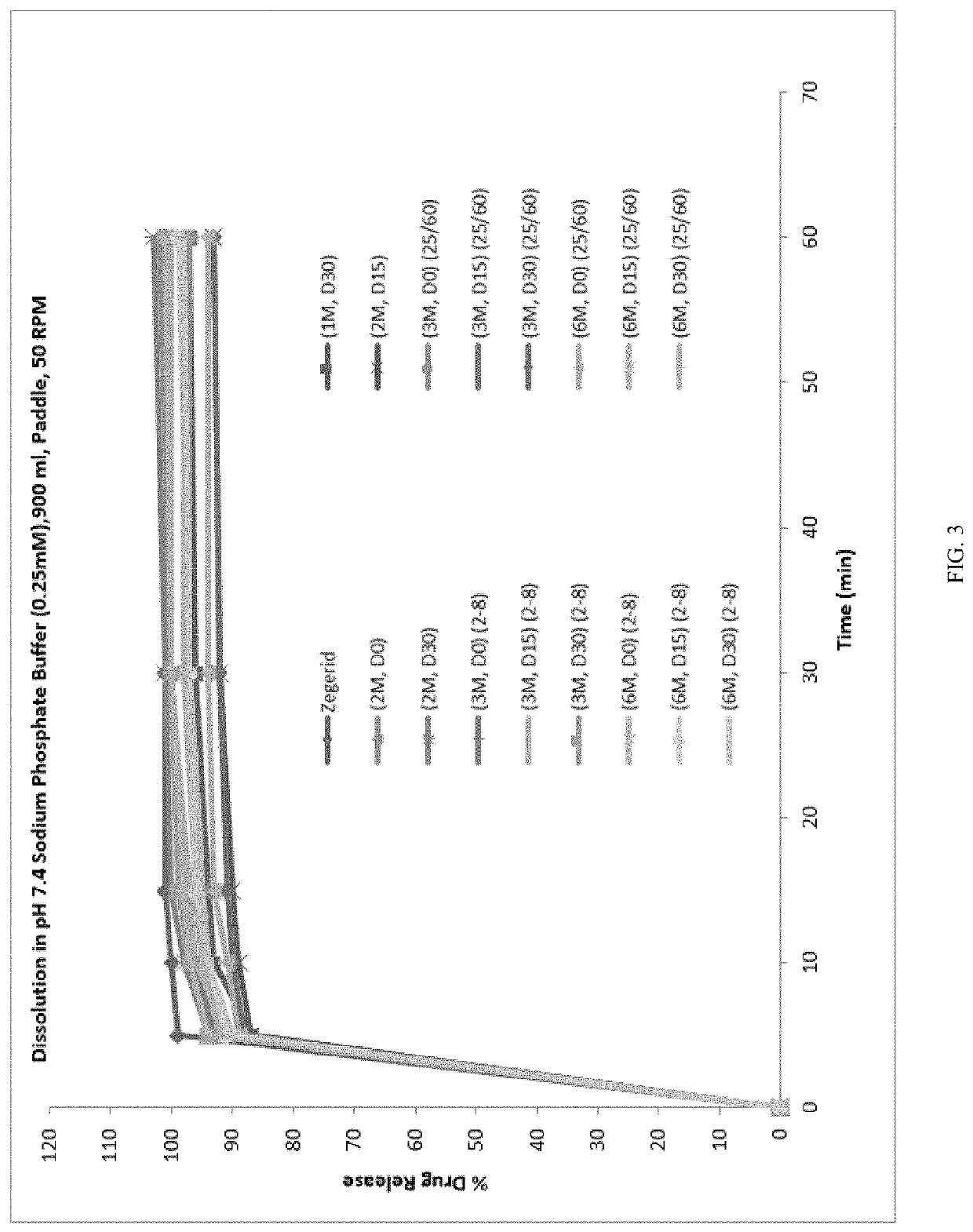Compositions and kits for omeprazole suspension
a technology of omeprazole and compositions, applied in the directions of drug compositions, dispersion delivery, inorganic non-active ingredients, etc., to achieve the effect of freezing-thawing stability
- Summary
- Abstract
- Description
- Claims
- Application Information
AI Technical Summary
Benefits of technology
Problems solved by technology
Method used
Image
Examples
example 1
of Surfactant and Suspending Agents for Diluent Reformulation
1.0 Formulation Development (Diluent Reformulation)
[0204]For the diluent reformulation studies the excipients which play a critical role were identified and evaluated. Surfactant and suspending agents were the two most critical excipient categories which were evaluated.
1.1 Surfactant Selection
[0205]The following three surfactants / wetting agents were screened for their ability to provide wettability of the API:
[0206]a. Poloxamer 188 (Kolliphor P 188)
[0207]b. Sodium Lauryl Sulfate (Kolliphor SLS fine)
[0208]c. Polysorbate 80 (Tween 80)
[0209]The three agents, poloxamer 188, sodium lauryl sulfate, and polysorbate 80, were evaluated at concentrations of 2% w / v, 0.1% w / v, and 0.1% w / v respectively. A control formulation without surfactant / wetting agent was also evaluated. Sodium bicarbonate was included in each formulation at a concentration of 8.4% w / v, as the concentration of sodium bicarbonate plays an important role in acid n...
example 2
n of Six Potential Prototype Formulations
2.0 Diluent Formulation Details
[0234]Below are the 6 prototype formulations (diluents; as described in Example 1) that were characterized and tested for stability herein. The formulations for these prototypes are provided in Table 6.
1. Sodium CMC+1.0% w / v poloxamer 188
2. Avicel CL-611+1.0% w / v poloxamer 188
3. Sodium CMC without w / v poloxamer 188
4. Sodium CMC without poloxamer 188 and sodium bicarbonate in physical mixture with API
5. Diluent Formula: 0093A-8 (4% w / v poloxamer 188)
6. Diluent Formula: 0093A-22 (2% w / v poloxamer 188)
2.1 Diluent Formula Composition and Procedure
[0235]
TABLE 6Diluent Formula Composition of the 6 prototype formulationsSodium CMCwithoutSodium CMCAvicel CL-Sodium CMCpoloxamer 188 &with611 withwithoutsodiumDiluentDiluentpoloxamerpoloxamerpoloxamerbicarbonate inFormulaFormula188188188physical mixture0093A-80093A-22Ingredient% w / v% w / v% w / v% w / v% w / v% w / vPoloxamer 18811NANA42(KolliphorP188)Sodium CMC1.2NA1.21.2NANA(Cekol ...
example 3
ization of Two Lead Prototype Formulations
3.1 Diluent Formula: Sodium CMC with 1% w / v Poloxamer 188
[0245]For the manufacturing of stability batches, the excipients used along with their function and an assigned test number are mentioned in the below table:
[0246]
IngredientFunction% w / vPoloxamer 188 (Kolliphor P188)Surfactant1Sodium CMC (Cekol 700P)Viscosity building / 1.2suspending agentSodium bicarbonateAcid neutralizing agent8.4Simethicone emulsionDefoamer0.15Strawberry Flavor CW08Flavoring agent0.1570% sorbitol solutionSweetener2.5Sodium citratePalatability enhancer / buffer1SucraloseSweetener0.4FD&C Red No. 40Coloring agent0.003Benzyl alcoholPreservative0.5WaterSolventq.s.
3.2 Description
[0247]For the two lead reconstituted suspensions, samples were physically observed at each stability time point. Data is summarized in the table below.
Specification: Pink to red hazy liquid.
A) Comparison of Sodium CMC+1.0% w / v poloxamer 188 reconstituted suspension at different stability time points:
[...
PUM
| Property | Measurement | Unit |
|---|---|---|
| pH | aaaaa | aaaaa |
| pH | aaaaa | aaaaa |
| pH | aaaaa | aaaaa |
Abstract
Description
Claims
Application Information
 Login to View More
Login to View More - R&D
- Intellectual Property
- Life Sciences
- Materials
- Tech Scout
- Unparalleled Data Quality
- Higher Quality Content
- 60% Fewer Hallucinations
Browse by: Latest US Patents, China's latest patents, Technical Efficacy Thesaurus, Application Domain, Technology Topic, Popular Technical Reports.
© 2025 PatSnap. All rights reserved.Legal|Privacy policy|Modern Slavery Act Transparency Statement|Sitemap|About US| Contact US: help@patsnap.com



